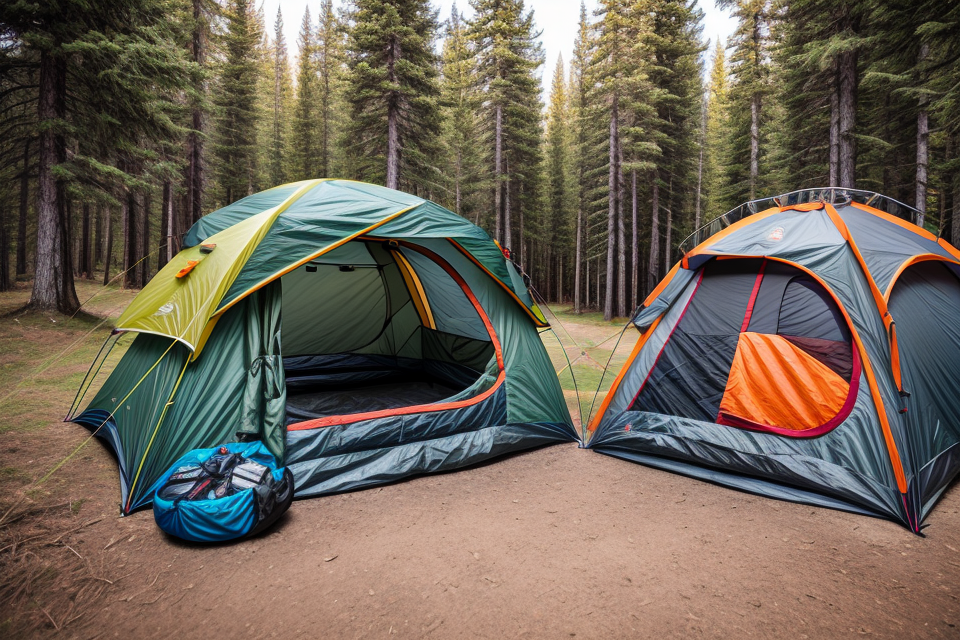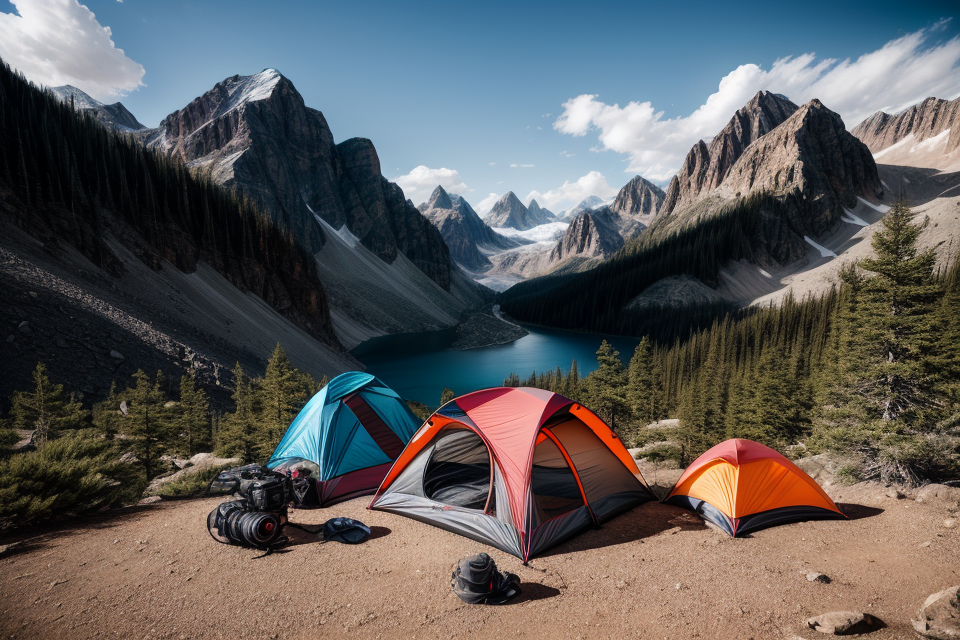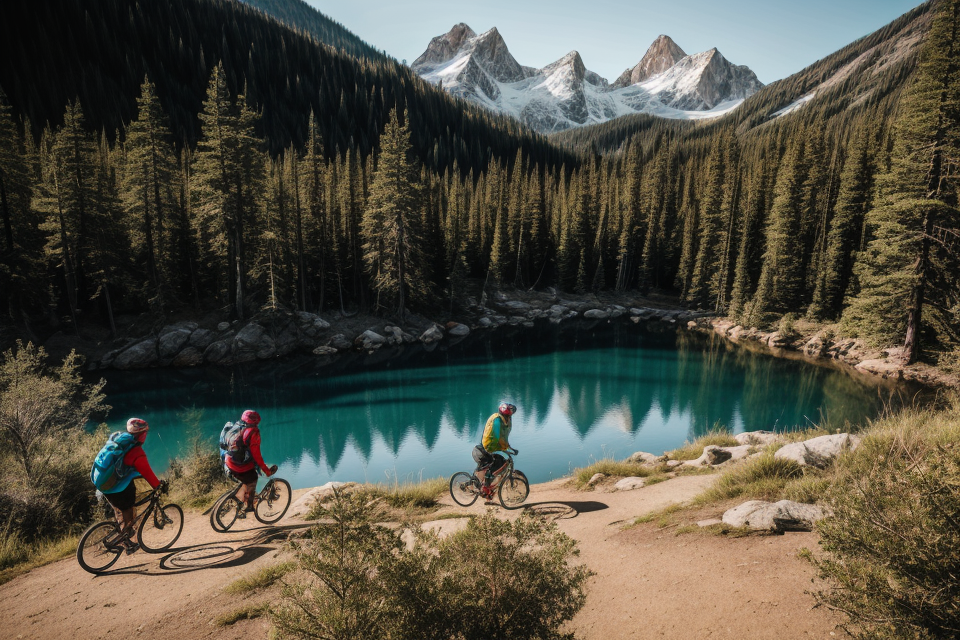Are you ready to embark on an exciting hiking adventure? Whether you’re a seasoned hiker or a beginner, having the right gear is essential for a safe and enjoyable trip. From footwear to backpacks, here’s a rundown of the essential hiking gear you’ll need for your next outdoor excursion.
Hiking boots or shoes are a must-have for any hiking adventure. They provide support and protection for your feet, and can help prevent injuries such as ankle sprains. A good backpack is also essential, as it allows you to carry all of your gear and supplies. Make sure to choose a backpack that is comfortable and has enough storage space for your needs.
Other essential hiking gear includes water bottles or hydration systems, snacks and energy bars, a first aid kit, and a map or GPS device. You may also want to bring a lightweight rain jacket or poncho, as well as extra layers of clothing for unexpected weather changes.
Investing in quality hiking gear can make a big difference in your hiking experience. By having the right gear, you can focus on enjoying the beauty of nature and making memories with friends and family. So, get ready to lace up your boots and hit the trails with confidence!
What is Hiking Gear?
Types of Hiking Gear
Hiking gear refers to the equipment and supplies that hikers need to ensure their safety, comfort, and convenience during a hike. There are various types of hiking gear, each serving a specific purpose and function. Understanding the different types of hiking gear is crucial in determining the essentials for your next hiking adventure.
Types of Hiking Gear:
- Clothing: Hiking gear includes clothing that is appropriate for the weather conditions and terrain of the hike. This includes hiking boots or shoes, socks, pants, shorts, long-sleeved shirts, and layers for colder temperatures.
- Shelter: Hiking gear also includes a shelter, such as a tent, backpacking tent, or hammock, to protect hikers from the elements.
- Backpack: A backpack is essential hiking gear for carrying essentials such as food, water, and other supplies. It should be comfortable, durable, and have enough storage space for the hike.
- Navigation tools: Navigation tools such as a compass, map, and GPS device are crucial for hikers to stay on track and avoid getting lost.
- First aid kit: A first aid kit containing essential items such as bandages, antiseptic wipes, and pain relievers can be crucial in case of accidents or injuries.
- Hydration system: Hiking gear also includes a hydration system such as a water bottle or hydration bladder to ensure hikers stay hydrated throughout the hike.
- Food: Hiking gear also includes food such as energy bars, trail mix, and other high-energy snacks to sustain hikers during the hike.
- Lighting equipment: Lighting equipment such as a flashlight or headlamp is essential for hiking in areas with limited sunlight or for navigating in the dark.
- Sleeping bag and pad: For overnight hikes, a sleeping bag and pad are essential hiking gear for getting a good night’s sleep.
- Insect repellent and sunscreen: Insect repellent and sunscreen are important for protecting hikers from insect bites and sun exposure.
Understanding the different types of hiking gear and their functions is essential in preparing for a hiking adventure. Having the right gear can make a significant difference in the overall experience and safety of the hike.
Importance of Hiking Gear
Proper hiking gear is crucial for a safe and enjoyable hiking experience. Hiking gear refers to the equipment and supplies that hikers use to ensure their safety, comfort, and convenience during a hike. The gear can range from essential items such as boots, backpacks, and water bottles to more specialized equipment like trekking poles, headlamps, and GPS devices.
The importance of hiking gear cannot be overstated. Without the right gear, hikers can face a range of challenges and potential dangers, including exposure to the elements, injuries, and even fatalities. The following are some reasons why hiking gear is essential:
- Protection from the elements: Hiking gear provides protection from the elements, such as rain, wind, and sun exposure. For example, waterproof jackets and pants, hat, and sunglasses help to keep hikers dry and comfortable in wet conditions. Sunblock and sunglasses protect hikers from the sun’s harmful UV rays.
- Safety: Hiking gear is also essential for safety. Items like a first aid kit, emergency whistle, and map and compass can help hikers respond to emergencies and navigate unfamiliar terrain.
- Comfort: Proper hiking gear can also increase comfort during a hike. Comfortable boots, a well-fitted backpack, and a hydration system can make a significant difference in how much a hiker enjoys their hike.
- Convenience: Hiking gear can also make a hike more convenient. Items like a headlamp, flashlight, and multi-tool can help hikers navigate and repair equipment during a hike.
In summary, hiking gear is essential for a safe, comfortable, and enjoyable hiking experience. It provides protection from the elements, helps hikers respond to emergencies, and increases convenience during a hike. Hikers should carefully consider their needs and the conditions of their hike when selecting hiking gear.
Footwear
Hiking Boots
Hiking boots are a crucial part of any hiking adventure, as they provide essential support and protection for your feet during long walks in the wilderness. These boots are specifically designed to meet the demands of rugged terrain and varying weather conditions, ensuring that your feet stay comfortable and safe throughout your journey. Here are some key features to consider when selecting the best hiking boots for your next adventure:
- Ankle Support: Look for boots with sturdy ankle support to prevent twists and sprains, which can be common injuries on steep trails. A good pair of hiking boots should provide stability and help maintain the natural alignment of your feet and ankles.
- Flexibility: Flexible hiking boots allow for better movement and comfort, as they are designed to mimic the natural movement of your foot. Opt for boots with a lightweight, breathable upper material, such as Gore-Tex or other waterproof-breathable membranes, to keep your feet dry and comfortable in wet conditions.
- Traction: Good traction is essential for maintaining balance on slippery or uneven surfaces. Look for boots with a durable, non-slip outsole with aggressive lugs that provide excellent grip on various terrains, including rocks, mud, and snow.
- Comfort: A well-fitting hiking boot should feel comfortable from the moment you put it on. Ensure that the boot has a supportive toe box, a cushioned midsole for shock absorption, and a comfortable, breathable lining. A snug fit around the heel and a secure lacing system will also contribute to the overall comfort of the boot.
- Durability: Invest in a pair of hiking boots that are built to last. Opt for boots made from high-quality materials, such as full-grain leather or heavy-duty synthetic fabrics, which are durable and resistant to abrasion, water, and wear. Look for reinforced toe and heel areas, as these are the most vulnerable parts of the boot.
- Weight: While hiking boots are designed to provide support and protection, they should not be overly heavy. A lightweight boot will make your hike more comfortable and enjoyable, as it reduces fatigue and allows for easier movement.
- Water Resistance: Waterproof boots are essential for hiking in wet or muddy conditions. Look for boots with a reliable waterproof-breathable membrane that prevents water from entering the boot while allowing moisture to escape. This will keep your feet dry and comfortable, even in the most challenging conditions.
In conclusion, selecting the right hiking boots is crucial for a successful and enjoyable hiking adventure. Consider the features outlined above to ensure that your boots provide the support, protection, and comfort you need to explore the great outdoors.
Hiking Shoes
Hiking shoes are a crucial part of any hiking adventure. They provide support, stability, and protection for your feet while on the trail. When choosing hiking shoes, it’s important to consider several factors, such as the terrain, the weather, and your personal preferences.
- Fit: A good pair of hiking shoes should fit snugly, but not too tight. A proper fit will ensure that your feet stay comfortable and blister-free during your hike.
- Flexibility: Look for hiking shoes that offer a good range of motion. This will allow your feet to move naturally while hiking, which can help prevent injuries.
- Ankle Support: Hiking shoes with strong ankle support can help prevent ankle injuries, especially on rough terrain.
- Traction: Hiking shoes with a good grip on the bottom can help prevent slips and falls on wet or uneven surfaces.
- Water Resistance: If you’ll be hiking in wet conditions, look for shoes that are water-resistant or made of materials that dry quickly.
- Weight: Lighter shoes can be more comfortable to wear for long periods, but they may not offer as much support or protection.
- Price: Hiking shoes can range from budget-friendly to high-end, depending on the features and materials.
When trying on hiking shoes, it’s important to break them in before your hike. This can help prevent blisters and other foot problems. It’s also a good idea to bring a pair of extra socks to change into if your feet get wet or uncomfortable during your hike.
In summary, when choosing hiking shoes, consider factors such as fit, flexibility, ankle support, traction, water resistance, weight, and price. Break in your shoes before your hike and bring extra socks for added comfort.
Trail Running Shoes
When it comes to hiking, trail running shoes are a popular choice among experienced hikers. These shoes are designed specifically for off-road adventures and provide a balance of support, traction, and flexibility.
Here are some key features to look for when choosing trail running shoes:
- Non-slip sole: A good trail running shoe should have a non-slip sole that provides excellent grip on different types of terrain, including rocks, mud, and snow.
- Flexible design: Trail running shoes should be lightweight and flexible, allowing you to move your feet easily while climbing and descending steep terrain.
- Supportive: The shoes should provide ample support for your feet, preventing blisters and other foot injuries. Look for a shoe with a sturdy toe box and a firm heel counter.
- Water-resistant: Trail running shoes should be water-resistant to keep your feet dry in wet conditions. This feature is especially important if you plan to hike in the rain or near water sources.
- Durability: Hiking shoes are designed to withstand the wear and tear of rough terrain, so make sure to choose a pair that is built to last. Look for shoes made with high-quality materials and reinforced stitching.
Overall, trail running shoes are an essential piece of gear for any hiking adventure. They provide the support, traction, and flexibility you need to tackle any terrain, and their lightweight design makes them easy to wear for long periods of time. When choosing trail running shoes, be sure to consider the specific features outlined above to ensure that you get the most out of your hiking experience.
Clothing
Layering Clothing
Proper clothing is crucial for a comfortable and safe hiking experience. One of the most important aspects of hiking attire is layering. Layering allows hikers to adjust their clothing according to changing weather conditions, which is particularly useful in unpredictable mountain environments.
When layering, it’s essential to prioritize breathability, moisture-wicking capabilities, and durability. Synthetic materials like polyester and nylon are popular choices for hiking apparel because they dry quickly, resist odors, and offer a high level of comfort.
Here are some key pieces to consider when layering for a hike:
- Base Layer: A moisture-wicking base layer, usually made of materials like merino wool or synthetic fabrics, is the first layer of clothing that comes into contact with your skin. This layer helps to move sweat away from your body and keeps you dry and comfortable.
- Mid-Layer: A mid-layer is added to provide insulation and warmth. This layer is typically worn when the temperature drops or when the weather becomes unpredictable. Mid-layers can be made from materials like fleece, down, or synthetic insulation.
- Outer Layer: The outer layer serves as a protective barrier against wind, rain, and snow. This layer should be waterproof and breathable to prevent moisture buildup. Common outer layer materials include Gore-Tex, eVent, and other advanced textile technologies.
Additionally, it’s essential to bring extra layers that can be easily added or removed throughout the hike. This way, you can adjust your clothing to match the changing weather conditions and maintain comfort.
Lastly, never underestimate the importance of appropriate footwear. Comfortable, sturdy, and waterproof boots are crucial for a successful hiking adventure. They will protect your feet from rough terrain, prevent blisters, and provide the support needed for long hikes.
In conclusion, when planning your next hiking adventure, pay close attention to your clothing choices. Layering is a critical aspect of hiking attire, providing the versatility needed to adapt to changing weather conditions. With the right clothing and footwear, you’ll be well-equipped to tackle any trail and enjoy a comfortable, safe, and memorable hiking experience.
Outerwear
When embarking on a hiking adventure, it is essential to dress appropriately for the occasion. Your outerwear is the first line of defense against the elements, and choosing the right clothing can make or break your hiking experience. Here are some factors to consider when selecting your outerwear for your next hiking adventure:
Material
The material of your outerwear is a crucial factor to consider. It should be lightweight, durable, and weather-resistant. Some popular materials for hiking outerwear include nylon, polyester, and cotton. Nylon is a popular choice because it is lightweight and has a high strength-to-weight ratio. Polyester is another lightweight option that is also moisture-wicking, making it ideal for hiking in wet conditions. Cotton, while comfortable, is not a recommended choice for hiking as it is heavy, absorbs moisture, and can cause rapid cooling when it becomes wet.
Fit
The fit of your outerwear is also essential. It should be loose enough to allow for movement but not so loose that it causes discomfort or hinders your movement. A well-fitting jacket will also prevent gaps that can allow cold air to penetrate. When trying on jackets, make sure to layer up and move around to ensure a proper fit.
Features
When choosing your outerwear, consider the features that will best suit your hiking needs. Some popular features include:
- Waterproofing: Look for jackets with a waterproof and breathable membrane to keep you dry in wet conditions.
- Wind resistance: Consider a jacket with a wind-resistant fabric to protect against harsh winds.
- Insulation: Insulated jackets are ideal for colder weather hikes. Look for jackets with synthetic insulation, such as polyester or nylon, which are lightweight and packable.
- Pockets: Consider a jacket with multiple pockets for storage, including at least one internal pocket to store sensitive items.
Layering
When selecting your outerwear, it is important to consider how it will work with your layering system. Your outerwear should be the final layer in your layering system, and it should work seamlessly with your base layers and mid-layers. Consider a jacket with a hood to protect against wind and rain, and choose a jacket that can be easily packed into its own pocket for easy transport.
In conclusion, your outerwear is a critical component of your hiking gear. Choose a lightweight, durable, and weather-resistant material, consider the fit, and look for features that will suit your hiking needs. Don’t forget to layer appropriately and choose a jacket with a hood to protect against the elements. With the right outerwear, you can focus on enjoying the beauty of nature without worrying about the weather.
Base Layers
Base layers are the first layer of clothing that comes in contact with your skin when you wear it. They are essential for providing a comfortable and functional foundation for your hiking outfit. There are different types of base layers available, each designed for specific purposes. Here are some of the most important features to consider when choosing base layers for your next hiking adventure:
Moisture-wicking properties
One of the most critical features of base layers is their ability to wick moisture away from your skin. This is particularly important when hiking, as you will be producing sweat, which can cause discomfort and chafing if it’s not evaporated quickly. Look for base layers made from materials like merino wool, synthetic blends, or even bamboo, which are known for their excellent moisture-wicking properties.
Breathability
Another important factor to consider is the breathability of your base layers. Since you’ll be exerting yourself during your hike, you’ll want to wear clothes that allow for airflow to keep you cool and comfortable. Breathable fabrics like mesh or moisture-wicking materials with a lofty texture are ideal for this purpose.
Temperature regulation
Different base layers are designed to regulate temperature in different ways. Some materials, like merino wool, are naturally thermoregulating, meaning they can keep you warm or cool depending on the conditions. Others may have a thin layer of insulation built into the fabric to help retain heat. It’s essential to choose a base layer that’s appropriate for the climate and weather conditions you’ll be facing on your hike.
Fit and comfort
Base layers should fit snugly but not restrictively. They should feel comfortable against your skin and not cause any irritation or chafing. Look for base layers with flat seams or no seams at all to minimize the risk of chafing. Choose a material that is soft and gentle on your skin to ensure a comfortable fit.
Durability
Hiking gear needs to be durable and able to withstand the wear and tear of regular use. Look for base layers made from high-quality materials that can withstand regular washing and wear without losing their shape or performance. It’s also a good idea to choose base layers that are resistant to tears or snags, as you may encounter rough terrain or brush during your hike.
By considering these factors when choosing base layers for your next hiking adventure, you can ensure that you’re wearing comfortable, functional, and durable clothing that will keep you comfortable and dry throughout your hike.
Accessories
Backpacks
When it comes to hiking, a good backpack is essential to carry all the necessary gear and supplies. The right backpack can make a significant difference in your comfort and convenience during the hike. Here are some key factors to consider when choosing a backpack for your next hiking adventure:
- Capacity: The capacity of the backpack should be sufficient to carry all the necessary gear and supplies for the duration of the hike. It is essential to consider the weight of the gear and the terrain when determining the capacity needed.
- Fit: A backpack that fits well is crucial for comfort during the hike. A good backpack should have a comfortable fit, with adjustable straps and a padded back to reduce pressure on the shoulders.
- Organization: A well-organized backpack can make a significant difference in finding gear quickly and easily. Look for a backpack with multiple compartments, pockets, and storage options to keep gear organized and accessible.
- Durability: A durable backpack can withstand the wear and tear of frequent use and various weather conditions. Look for a backpack made from high-quality materials that can withstand rain, snow, and rough terrain.
- Weight: While a backpack should be large enough to carry all the necessary gear, it is also essential to consider its weight. A heavy backpack can cause discomfort and fatigue during the hike, so choose a backpack that is lightweight but still provides enough capacity.
- Hydration system: Some backpacks come with a built-in hydration system, which can be a convenient feature to have during a hike. Consider a backpack with a dedicated hydration bladder or a hydration tube that can be connected to a water bottle.
- Comfort features: Look for a backpack with padded shoulder straps, a padded back, and a waist belt to distribute the weight of the backpack evenly and provide maximum comfort during the hike.
- Visibility: In some cases, a backpack with reflective materials or a light-up feature can increase visibility in low-light conditions, making it safer for early morning or evening hikes.
In summary, choosing the right backpack for your next hiking adventure is crucial for comfort and convenience. Consider the capacity, fit, organization, durability, weight, hydration system, comfort features, and visibility when selecting a backpack. With the right backpack, you can focus on enjoying the hike instead of worrying about carrying your gear.
Hydration Systems
Hydration systems are essential for hikers as they provide a convenient and efficient way to stay hydrated during their hike. These systems come in different forms, such as water bottles, hydration packs, and camelbacks. Each type has its own advantages and disadvantages, so it’s important to choose the one that best suits your needs.
Water Bottles
Water bottles are the most basic form of hydration system. They are lightweight, durable, and easy to use. They can be filled with water from natural sources, such as streams and rivers, or from designated water sources along the trail. They are also affordable and can be easily replaced if lost or damaged.
Hydration Packs
Hydration packs are more advanced than water bottles as they allow the hiker to carry both water and other essentials, such as snacks and first aid supplies. They come in different sizes and designs, ranging from small waist packs to large backpacks. They typically have a bladder that can be filled with water and connected to a tube that allows the hiker to drink without having to stop and take off their pack.
Camelbacks
Camelbacks are similar to hydration packs, but they are integrated into a backpack. They have a bladder that can be filled with water and connected to a tube that allows the hiker to drink without having to stop and take off their pack. They are lightweight and provide easy access to water, but they can be more expensive than water bottles or hydration packs.
It’s important to choose the right hydration system for your hike based on factors such as the length of the hike, the terrain, and the weather conditions. Whatever system you choose, make sure to bring enough water to last for the entire hike and to regularly refill your water bottle or hydration system to ensure that you stay hydrated throughout the day.
Headlamps/Flashlights
When it comes to hiking, having a reliable source of light is crucial. Whether you’re navigating through a dense forest or hiking up a steep mountain trail, having a headlamp or flashlight can make all the difference. Here are some things to consider when choosing a headlamp or flashlight for your next hiking adventure:
- Battery Life: Look for a headlamp or flashlight that has a long battery life. This way, you won’t have to worry about running out of power in the middle of your hike.
- Brightness: Consider the brightness of the light. Some headlamps and flashlights have multiple settings, so you can adjust the brightness depending on your needs.
- Beam Distance: Think about how far you’ll need the light to reach. If you’ll be hiking in a densely wooded area, you’ll want a headlamp or flashlight with a longer beam distance.
- Weight: If you’ll be carrying your headlamp or flashlight for an extended period, you’ll want to choose one that’s lightweight.
- Comfort: Look for a headlamp or flashlight that’s comfortable to wear. Some headlamps have adjustable straps, while others have padded earpieces to help with comfort.
- Water Resistance: If you’ll be hiking in wet conditions, look for a headlamp or flashlight that’s water-resistant. This will help protect the light from damage due to rain or sweat.
- Additional Features: Some headlamps and flashlights come with additional features, such as red lights for night vision or a strobe mode for signaling. Consider whether these features are important to you and choose a light that includes them.
By considering these factors, you can choose a headlamp or flashlight that will provide the light you need for your next hiking adventure.
Navigation Tools
Navigation tools are a crucial component of any hiking adventure, as they help hikers stay on track and avoid getting lost in the wilderness. Here are some essential navigation tools that every hiker should consider bringing on their next hiking trip:
Compass
A compass is a simple yet essential navigation tool that every hiker should have. It helps hikers determine their direction and navigate through unfamiliar terrain. A compass consists of a magnetic needle that points towards the Earth’s magnetic north pole, and a base plate that includes a map of the area.
GPS Device
A GPS (Global Positioning System) device is a technological tool that uses satellites to determine a hiker’s exact location. GPS devices can be handheld or built into a smartphone, and they provide accurate information about a hiker’s location, elevation, and distance. GPS devices are particularly useful in areas with poor visibility or where it’s easy to get disoriented.
Maps
Maps are essential navigation tools that help hikers plan their route and navigate through unfamiliar terrain. Hikers should bring a detailed map of the area they plan to hike, as well as a compass to help them navigate. It’s also a good idea to bring a topographic map, which provides more detailed information about the terrain, including elevation and water features.
Altimeter
An altimeter is a tool that measures a hiker’s elevation above sea level. It’s particularly useful for hikers who plan to climb mountains or hike in areas with significant elevation changes. An altimeter can help hikers determine their current elevation and track their progress as they ascend or descend.
Headlamp or Flashlight
A headlamp or flashlight is an essential navigation tool for hikers who plan to hike in areas with poor visibility or after dark. A headlamp provides hands-free lighting, which is particularly useful when navigating through rough terrain. A flashlight is a more traditional option that can be used in a variety of situations.
Overall, navigation tools are crucial for any hiking adventure, as they help hikers stay on track and avoid getting lost in the wilderness. By bringing a compass, GPS device, maps, altimeter, and headlamp or flashlight, hikers can ensure that they have the essential tools they need to navigate safely and enjoyably through the great outdoors.
Personal Protection
First Aid Kits
When embarking on a hiking adventure, it is crucial to prioritize personal safety. One essential aspect of personal protection is being prepared with a comprehensive first aid kit. A well-equipped first aid kit can make all the difference in case of an unexpected injury or emergency. Here are some essential items to include in your first aid kit:
- Adhesive bandages: A variety of sizes, including small, medium, and large, to accommodate different types of wounds.
- Gauze: Gauze is a versatile material that can be used for dressing wounds, as well as for packing and protecting injured areas.
- Sterile gauze: For more serious wounds, sterile gauze is necessary to prevent infection.
- Triangular bandages: These are useful for immobilizing injured limbs and for covering wounds.
- Roller gauze: Roller gauze is ideal for wrapping around limbs and securing with tape.
- Tweezers: Tweezers are essential for removing splinters, ticks, and other foreign objects from the skin.
- Scissors: Scissors are useful for cutting adhesive bandages, gauze, and other materials.
- Pain relievers: Pain relievers such as aspirin or ibuprofen can be helpful in alleviating pain and reducing inflammation.
- Antihistamines: Antihistamines can be useful in treating allergic reactions and insect bites.
- Antiseptic wipes or spray: Antiseptic wipes or spray can be used to clean wounds and prevent infection.
- Instant ice packs: Instant ice packs are essential for treating sprains, strains, and other injuries that require cold therapy.
- Gloves: Pair of disposable gloves can be useful for preventing cross-contamination and protecting against blood-borne pathogens.
- A guidebook on basic first aid: A guidebook can be helpful in providing instructions on how to use the contents of the first aid kit.
It is important to note that first aid kits should be tailored to the specific needs of the individual and the nature of the hike. Hikers should also consider carrying additional items such as a whistle, flashlight, and extra food and water in case of an emergency. By being prepared with a comprehensive first aid kit, hikers can enjoy their adventure with peace of mind, knowing that they are equipped to handle any unexpected situations that may arise.
Insect Repellent
When embarking on a hiking adventure, it’s crucial to take necessary precautions to protect yourself from potential hazards. One such precaution is to use insect repellent to ward off pesky insects that can cause irritation or even more severe health problems. Here are some important factors to consider when choosing the right insect repellent for your next hiking trip:
- Active Ingredients: Different insect repellents contain various active ingredients that can either repel or kill insects. The most common active ingredients used in insect repellents are DEET, picaridin, oil of lemon eucalyptus, and IR3535. Each of these ingredients has its own set of advantages and disadvantages, so it’s essential to research and choose the one that best suits your needs.
- Protection Time: Insect repellents typically provide a certain amount of time before they need to be reapplied. It’s important to choose a repellent that offers sufficient protection for the duration of your hike.
- Skin Sensitivity: Some people may have sensitive skin that can react poorly to certain ingredients in insect repellents. If you have sensitive skin, it’s essential to choose a repellent that is hypoallergenic and won’t cause any irritation.
- Eco-Friendliness: If you’re an environmentally conscious hiker, you may want to choose an insect repellent that is eco-friendly and won’t harm the environment. Look for repellents that use natural ingredients or are biodegradable.
- Child Safety: If you’re hiking with children, it’s important to choose an insect repellent that is safe for them to use. Always read the label carefully and follow the instructions for use.
In conclusion, choosing the right insect repellent is an essential part of personal protection when hiking. Consider the active ingredients, protection time, skin sensitivity, eco-friendliness, and child safety when selecting the best insect repellent for your next hiking adventure.
Sun Protection
Hiking in the great outdoors can be an exhilarating experience, but it also comes with its own set of challenges. One of the most significant risks associated with hiking is exposure to the sun’s harmful ultraviolet (UV) rays. Prolonged exposure to these rays can lead to sunburn, dehydration, heat exhaustion, and even skin cancer. Therefore, it is crucial to take adequate measures to protect yourself from the sun’s harmful effects.
There are several essential pieces of gear that you should consider when it comes to sun protection while hiking. First and foremost, it is essential to wear appropriate clothing. Lightweight, loose-fitting clothes made from breathable fabrics such as cotton or synthetic materials are ideal. Opt for clothing that covers your arms and legs to prevent direct sun exposure. A wide-brimmed hat and sunglasses are also excellent options to protect your face and eyes from the sun’s rays.
In addition to clothing, it is also essential to use sunscreen to protect your skin. Look for a broad-spectrum sunscreen with an SPF of at least 30, which will protect against both UVA and UVB rays. Apply sunscreen generously to all exposed areas of skin at least 15 minutes before heading out on your hike. Be sure to reapply every two hours or immediately after swimming or sweating.
Finally, it is crucial to stay hydrated while hiking. The sun’s heat can cause dehydration quickly, so it is essential to bring plenty of water with you. Aim to drink at least one liter of water per hour while hiking, and bring electrolyte-rich sports drinks or energy gels to help maintain your energy levels.
By taking these simple steps to protect yourself from the sun, you can enjoy your hiking adventure without putting your health at risk. Remember, it is always better to be safe than sorry, so don’t skimp on the sun protection!
Nutrition and Hydration
Food Options
Proper nutrition and hydration are crucial components of any successful hiking adventure. As you embark on your journey, it’s important to have the right food options to keep you fueled and energized throughout your hike. Here are some key considerations to keep in mind when selecting food options for your next hiking adventure:
- Weight and portability: When hiking, every ounce counts. Choose foods that are lightweight and easy to carry, such as energy bars, trail mix, and dried fruits. These options provide a convenient source of energy and nutrients without adding excess weight to your pack.
- Nutrient density: Opt for foods that are high in nutrients and provide sustained energy. This may include whole grains, nuts, seeds, and fruits and vegetables. These foods will help you stay fueled and energized throughout your hike.
- Individual needs: Consider your own personal needs and preferences when selecting food options. If you have specific dietary restrictions or preferences, make sure to bring foods that align with your needs. Additionally, consider your own personal tastes and preferences when selecting foods for your hike.
- Ease of preparation: Choose foods that are easy to prepare and don’t require extensive cooking or preparation. This may include foods that can be eaten raw, such as fruit or energy bars, or foods that can be quickly prepared with minimal equipment, such as instant oatmeal or canned soup.
- Variety: To prevent boredom and ensure that you have a variety of options, bring a mix of different foods. This may include snacks like energy bars, trail mix, and dried fruits, as well as more substantial meals like canned tuna or chicken, instant noodles, or dehydrated meals.
By considering these factors and selecting the right food options for your hike, you can ensure that you have the energy and nutrients you need to fully enjoy your adventure.
Hydration Options
Maintaining proper hydration is crucial during any hiking adventure. Dehydration can lead to fatigue, dizziness, and even more severe health consequences. Therefore, it is essential to have access to suitable hydration options during your hike.
- Water Bottles: One of the most straightforward and cost-effective ways to stay hydrated is by carrying a water bottle. Lightweight and durable, water bottles are designed to withstand the toughest of hiking conditions. A minimum of one liter per person per day is recommended, with more for hot weather or higher altitudes.
- Hydration Bladders: For those who prefer a more hands-free approach, hydration bladders are an excellent option. These lightweight, flexible bladders attach to the backpack and have a tube that allows for easy sipping. They hold a significant amount of water and can be refilled at water sources along the trail.
- CamelBak: CamelBak is a brand that specializes in hydration systems, offering both water bottles and hydration bladders. Their products are designed with comfort and convenience in mind, with features such as insulated covers and easy-to-clean designs.
- Electrolyte Tablets: In addition to water, electrolyte tablets can help to replace essential minerals lost during sweating and physical activity. These tablets can be added to water to create an electrolyte-rich beverage that helps to maintain proper hydration levels. Popular brands include Nuun and GU Energy.
- Hydration Drinks: For those who prefer a more flavorful hydration option, there are several sports drinks available that provide both hydration and electrolytes. These drinks can be found in powder or ready-to-drink form and are commonly used by athletes. Examples include Gatorade and Powerade.
In conclusion, proper hydration is essential for a successful and enjoyable hiking adventure. Whether you choose water bottles, hydration bladders, or electrolyte tablets, ensure that you have access to the necessary hydration options to keep you and your fellow hikers safe and healthy.
Hydration Bladders
When embarking on a hiking adventure, it is crucial to prioritize hydration to ensure a safe and enjoyable experience. Hydration bladders are an essential piece of gear for hikers as they allow for easy access to water during the hike. Here are some key features to consider when selecting a hydration bladder:
- Capacity: Hydration bladders come in various sizes, ranging from 500ml to 3 liters. Choose a bladder that can hold enough water to sustain you throughout your hike.
- Material: Many hydration bladders are made of durable, lightweight materials such as Tritan or Eastman Tritan. These materials are resistant to punctures and are easy to clean.
- Closure System: The closure system is a critical component of a hydration bladder. Look for a system that is easy to use and secure, such as a bite valve or a screw-on cap.
- Hydration Bladder Accessories: Consider purchasing additional accessories such as a hose or squeeze bottle to make it easier to access water while on the trail.
- Portability: Choose a hydration bladder that is compact and lightweight, making it easy to carry on your hike.
- Reservoir Location: Consider the location of the reservoir when selecting a hydration bladder. Some bladders are designed to be carried on the back, while others can be attached to a belt or pack.
- Ease of Cleaning: Hydration bladders can be challenging to clean, so choose a bladder with a simple design that is easy to clean.
Overall, investing in a high-quality hydration bladder is essential for any hiking adventure. Consider these key features to ensure that you have a safe and enjoyable experience on the trail.
Safety Equipment
Emergency Shelter
When embarking on a hiking adventure, it’s crucial to be prepared for any situation that may arise. One essential piece of gear that should always be in your backpack is an emergency shelter. This could mean the difference between a comfortable night’s rest and a miserable one, or even the difference between life and death in extreme circumstances.
An emergency shelter is a lightweight, portable shelter that can be quickly set up in case of inclement weather or other emergencies. It is designed to provide protection from the elements, such as rain, wind, and snow. These shelters typically come in the form of a tarp or a tent, and can be easily packed into a small carrying case.
When choosing an emergency shelter, it’s important to consider the terrain and climate you’ll be hiking in. For example, if you’re hiking in a particularly rainy area, you may want to choose a shelter that is designed to withstand heavy rain and wind. On the other hand, if you’re hiking in a dry, hot climate, a lightweight tarp may be sufficient.
It’s also important to consider the size of the emergency shelter you’ll need. If you’re hiking alone, a one-person shelter may be sufficient. However, if you’re hiking with a group, you may want to consider a larger shelter that can accommodate multiple people.
In addition to providing protection from the elements, an emergency shelter can also serve as a safe haven in case of an emergency. For example, if you become lost or injured, you can use your emergency shelter as a base camp while you wait for rescue.
Overall, an emergency shelter is an essential piece of gear for any hiking adventure. It’s lightweight, portable, and can provide protection from the elements and serve as a safe haven in case of an emergency. So, be sure to pack one in your backpack before embarking on your next hiking adventure.
Signaling Devices
When embarking on a hiking adventure, it’s crucial to bring the right safety equipment to ensure your well-being. Among the most essential safety gear for hikers are signaling devices. These devices can help you communicate your location to rescue teams in case you get lost or injured.
Here are some types of signaling devices that you should consider bringing on your next hiking adventure:
- Whistle: A whistle is a small, inexpensive device that can be used to signal for help. It’s easy to carry and can be heard from a distance, making it an ideal safety tool for hikers.
- Emergency beacon: An emergency beacon is a device that sends out a distress signal to rescue teams. It’s a reliable way to call for help in case you get lost or injured, and it’s particularly useful for solo hikers.
- Flares: Flares are a visual signaling device that can be used to attract attention. They can be seen from a distance, and they’re particularly useful for signaling at night or in low-light conditions.
- Mirror: A mirror is a simple yet effective signaling device that can be used to reflect sunlight and attract attention. It’s a lightweight and inexpensive option that can be easily carried in your backpack.
When choosing signaling devices, it’s important to consider the specific conditions of your hike. For example, if you’ll be hiking in an area with a lot of snow, an emergency beacon may be more useful than flares. Similarly, if you’ll be hiking in a remote area with no cell phone reception, a whistle or mirror may be more reliable than a cell phone.
In addition to these devices, it’s also important to bring extra batteries and to keep them in a safe and accessible location. By carrying the right signaling devices and using them appropriately, you can increase your chances of staying safe on your next hiking adventure.
Rescue Gear
When embarking on a hiking adventure, it’s crucial to be prepared for any situation that may arise. This includes having the right rescue gear to ensure your safety in case of an emergency. Here are some essential rescue gear items to consider for your next hiking trip:
- First Aid Kit: A well-stocked first aid kit is essential for treating injuries and preventing infection. It should include items such as adhesive bandages, gauze, tweezers, antiseptic wipes, and pain relievers.
- Emergency Shelter: An emergency shelter is necessary if you find yourself stranded in inclement weather. It can provide protection from the elements, keeping you warm and dry until help arrives.
- Signaling Devices: Signaling devices such as whistles, flares, and signal mirrors are essential for attracting attention in case you become lost or injured. These devices can help rescuers locate you quickly and efficiently.
- Navigation Tools: Navigation tools such as a compass and map are essential for finding your way in unfamiliar terrain. These tools can help you stay on course and avoid getting lost.
- Survival Knife: A survival knife is a versatile tool that can be used for a variety of tasks, including cutting, carving, splitting, and even for self-defense. It’s essential to have a sturdy and reliable knife in case of an emergency.
- Hydration System: Staying hydrated is crucial when hiking, especially in hot and humid conditions. A hydration system such as a water bladder or camelback can help you stay hydrated throughout your hike.
- Extra Clothing: It’s always a good idea to bring extra clothing, especially if you’re hiking in an unpredictable climate. Extra layers can keep you warm in cold weather and can also be used as protection against the elements.
- Food: Bringing enough food to sustain you throughout your hike is essential. High-energy foods such as trail mix, energy bars, and jerky can provide the energy you need to stay fueled throughout your adventure.
By packing these essential rescue gear items, you can ensure your safety and preparedness for any situation that may arise on your next hiking adventure.
Tips for Planning Your Hiking Adventure
Planning your hiking adventure is essential to ensure a safe and enjoyable experience. Here are some tips to consider when planning your next hiking trip:
- Research the trail: Before embarking on your hike, research the trail you plan to take. Look for information on the trail’s length, difficulty, and any potential hazards. This will help you determine the necessary safety equipment and gear you’ll need for your hike.
- Check the weather: Check the weather forecast before you start your hike. Be prepared for any weather conditions that may arise, such as rain, snow, or extreme heat. Make sure you have the appropriate clothing and gear to protect yourself from the elements.
- Tell someone your plans: Let someone know your plans and provide them with a detailed itinerary. This includes the trail you plan to take, the starting and ending points, and the expected time of return. This way, if you don’t return on time, someone will know where to look for you.
- Bring enough food and water: Make sure you bring enough food and water for your hike. Bring snacks and energy bars to keep your energy levels up, and make sure you have enough water to stay hydrated throughout your hike.
- Stay on the trail: Stay on the designated trail to avoid getting lost or injured. Straying from the trail can lead to unstable terrain, wildlife encounters, and other hazards.
- Be prepared for emergencies: Be prepared for any emergencies that may arise. Bring a first aid kit, a map, and a compass, and know how to use them. Also, consider bringing a satellite phone or a personal locator beacon in case you need to call for help.
By following these tips, you can ensure a safe and enjoyable hiking adventure.
FAQs
1. What are the essential items of hiking gear?
The essential items of hiking gear include a good quality backpack, water bottles or hydration system, comfortable and sturdy hiking boots or shoes, hiking poles, headlamp or flashlight, first aid kit, map and compass or GPS device, sun protection, warm layers, and rain gear.
2. What type of backpack should I choose for hiking?
Choose a backpack that is comfortable, durable, and has enough storage space for your gear. It should also have adjustable shoulder straps and a hip belt for better support. The backpack should also have pockets for easy access to essentials like water bottles and snacks.
3. What kind of footwear is best for hiking?
Hiking boots or shoes that are sturdy, comfortable, and provide good ankle support are ideal for hiking. Look for a shoe or boot with a non-slip sole and good traction for different terrain. Hiking shoes with a sturdy toe and ankle protection are also recommended.
4. Why do I need hiking poles?
Hiking poles provide support and stability on uneven terrain, reduce stress on your knees and hips, and help you maintain balance on steep inclines. They also come in handy when crossing streams or rivers and can be used to help you climb over obstacles.
5. What should I wear for hiking?
Wear comfortable, moisture-wicking layers that can regulate your body temperature. Bring warm layers for cooler weather and sun protection such as a hat and sunglasses. Choose sturdy, comfortable pants that offer sun protection and can withstand brush and briars.
6. What is the best way to stay hydrated while hiking?
Drink water or hydration drinks regularly, especially during hot weather or high-intensity hikes. Bring enough water or hydration fluid to last for the entire hike and refill at water sources along the way. Carry a water filter or purification tablets to ensure your water is safe to drink.
7. What should I do if I get lost while hiking?
Stay calm and retrace your steps to where you were last sure of your location. Use your map and compass or GPS device to navigate back to your intended route. If you are unable to navigate back, stay put and wait for rescue.
8. What is the best way to prevent blisters while hiking?
Wear shoes or boots that fit well and have a good break-in period. Bring extra socks and wear them to prevent blisters. Use moleskin or other blister prevention products to protect high-risk areas like the heel and toe. Make sure your shoes or boots are properly broken in before starting your hike.










